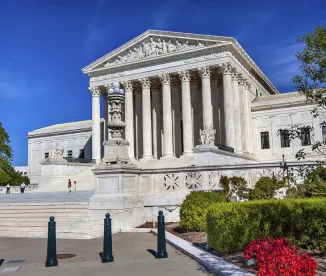Title VII of the Civil Rights Act of 1964 prohibits employers from discriminating against any individual “because of such individual’s race, color, religion, sex, or national origin.” 42 U.S.C. § 2000e–2(a). Last week, the Court decided three consolidated cases—Bostock v. Clayton County, Altitude Express v. Zarda, and R.G. & G.R. Harris Funeral Homes v. EEOC, 2020 WL 3146686 (U.S. June 15, 2020)—that ask whether an employer who discriminates against a gay, lesbian, or transgender worker is discriminating against that individual “because of such individual’s … sex.” The Court answered in the affirmative. In a 6-3 decision, the Court held that discrimination against gay and transgender employees is discrimination because of sex in violation of Title VII.
Background on the Sex Discrimination Cases
In the three consolidated cases, employees were fired because they were gay or transgender. Gerald Bostock was a child welfare advocate for Clayton County, Georgia. After participating in a gay recreational softball league, Clayton County terminated his employment for conduct “unbecoming” a county employee. Donald Zarda was a skydiving instructor at Altitude Express in New York, fired after revealing that he was gay. Aimee Stephens worked at R. G. & G. R. Harris Funeral Homes in Garden City, Michigan. She presented as male when she began the job, then the funeral home terminated her employment after she wrote a letter to her employer explaining that she planned to “live and work full-time as a woman.”
Each of the three employees brought sex discrimination suits under Title VII. While the Second Circuit and Sixth Circuit recognized Mr. Zarda and Ms. Stephens’s claims respectively, the Eleventh Circuit dismissed Mr. Bostock’s case, holding that Title VII does not prohibit discrimination on the basis of sexual orientation as a matter of law. The Supreme Court granted certiorari to resolve whether Title VII protects gay and transgender individuals from discrimination in employment.
Textualist Holding
The Court’s opinion by Justice Gorsuch (joined by Chief Justice Roberts, and Justices Ginsburg, Breyer, Sotomayor, and Kagan), as well as the dissenting opinions by Justices Alito and Kavanaugh (Justice Thomas joined Justice Alito’s dissent), all started with the premise that the judicial task was to apply the plain meaning of the text of the statute. The parties primarily disputed the meaning of the term “sex” but the Court accepted the employers’ view that the term “sex” refers to “biological distinctions between male and female.” 2020 WL 3146686 at *4. The Court emphasized that was only a starting point and the real interpretive question was what Title VII says about sex, namely that it is unlawful for employers to take adverse employment actions because of an individual’s sex. The Court reiterated its prior holdings that “because of” incorporates the traditional standard of “but-for” causation. But-for causation is established whenever a particular outcome would not have happened “but for” the purported cause. “In other words, a but-for test directs us to change one thing at a time and see if the outcome changes. If it does, we have found a but-for cause.” Id. Applying this standard, an action is illegal if it would not have occurred but for sex, even if other causes were at play.
The Court made a number of crucial observations about the meaning of but-for causation. The Court emphasized this is a “sweeping standard” and that events can have more than one cause so a defendant cannot avoid liability by citing some other factor that contributed to its decision so long as the plaintiff’s sex was one but-for cause of the decision. The Court noted that Congress could have adopted a sole cause or primary cause standard, but in fact had gone in the opposite direction by enacting the “motivating factor” provision, a more forgiving standard than but-for causation. Under the traditional but-for standard the key to liability is whether the defendant has intentionally discriminated against the plaintiff because of his or her sex.
The Court briefly reviewed the meaning of discrimination to conclude that an employer who treats a person worse because of sex, “such as by firing the person for actions or attributes it would tolerate in an individual of another sex” violates Title VII. Id. at *5. In reaching that conclusion the Court also addressed the possibility that discrimination on the basis of sex requires a showing that women in general are treated less favorably as a group than men are, but emphatically rejected that possibility because of Title VII’s consistent reference to discrimination against individuals.
Based on its explanation of all the key statutory terms, the Court derived its straightforward rule that an employer violates Title VII when it fires an individual employee based in part on sex, and that it does not matter if other factors also contributed to the decision, nor does it matter if women and men as groups are treated the same. Applying that rule to the claims in these cases, the Court held that “it is impossible to discriminate against a person for being gaysexual or transgender without discriminating against that individual based on sex.” Id. at *7. That is so, the Court reasoned, because when an employer fires a man who is attracted to a man but not a woman who is attracted to a man, that means the employee’s sex is a but-for cause of his discharge. Similarly, firing a transgender person whose identity at birth was female but not a woman whose identity at birth was female means that the employee’s sex plays an impermissible role in the discharge decision. The Court stressed in each case the employer was penalizing an employee for “traits or actions that it tolerates” in an employee of the other sex. Id. Put another way, the Court stressed that “homosexuality and transgender status are inextricably bound up with sex.” Id.
The Court reviewed three prior decisions that support its textual interpretation—Phillips v. Martin Marietta Corp., 400U.S. 542 (1971), in which an employer refused to hire women with young children; Los Angeles Dept. of Water and Power v Manhart, 435 U.S. 702 (1978), in which an employer required women to pay higher pension fund contributions than men; and Oncale v. Sundowner Offshore Services, Inc., 523 U.S. 75 (1998), in which male employees subjected a male co-worker to sexual harassment. The Court used the facts and reasoning of those cases to support its conclusions: that it does not matter what other motivations or descriptive labels can be attached to discrimination that is motivated in part by an individual’s sex; that sex need not be the sole or primary cause of the adverse action; and that treating males and females comparably as groups will not negate liability for discrimination on the basis of sex against an individual. Bostock, 2020 WL 3146686 at *9.
In deciding these cases based on the text of Title VII, the Court rejected arguments that it should consider the common understanding of the terms at issue or the legislative history of what Congress may have thought the term “sex” meant in 1964 when it enacted Title VII, or the sweeping impact of this important new application of the law. Instead, the Court reiterated that “[w]hen the express terms of a statute give us one answer and extratextual considerations suggest another, it’s no contest. Only the written word is the law, and all persons are entitled to its benefit.” Id. at *3.
In holding that discrimination against gay and transgender individuals constitutes sex discrimination, the central rationale of the opinion is that an adverse action can have multiple but-for causes. According to the Court, discrimination based on sexual orientation or gender identity necessarily means that biological sex is one of multiple “but-for” causes. “That’s because it is impossible to discriminate against a person for being homosexual or transgender without discriminating against that individual based on sex.” Id. at *7. Sex is necessarily a but-for cause when an employer discriminates against gay or transgender employees, but it need not be the sole cause, or even the primary cause.
The Court briefly addressed the allegedly dire consequences the dissenting Justices enumerated as flowing from its decision—the impact on other federal laws that prohibit sex discrimination, the effect of this ruling on sex-segregated bathrooms, locker rooms, and dress codes, as well as possible conflicts with the religious convictions of some employers. Since none of those issues were presented in these cases, the Court declined to address them, as they are questions for future cases.
Additional Implications of the SCOTUS Ruling
It is notable that the Court’s explication of the meaning of but-for cause was used to explain why discrimination on the basis of LGBTQ status is sex discrimination. The employers in these cases admitted discharging the plaintiffs because they were gay or transgender, so there was no other causation or motivation question in the cases. Going forward employers will be less likely to admit they discharged or refused to hire an individual on this basis. In future cases, the Title VII causation standards, whether “because of” or “motivating factor,” will factor into the analysis of whether an LGBTQ plaintiff can state or prove a claim that an adverse action was caused or motivated by their sex. In other words, LGBTQ plaintiffs will face the same challenges as all other discrimination plaintiffs in showing it was their sex and not asserted nondiscriminatory reasons such as their performance that motivated their discharge or other adverse action. The Court’s emphasis on the breadth of but-for cause, especially its repeated admonition that it need not be the only or primary cause, should help all discrimination plaintiffs in meeting that burden.
In addition to providing useful guidance on the meaning of but-for cause and eliminating any argument that it must mean a primary or sole cause, the Court’s opinion makes other points that may be useful in other contexts. For example, although the Court does not rely on the Price Waterhouse v. Hopkins, 490 U.S. 338 (1989), analysis of the role of stereotypes in proving sex discrimination, it states several times in Bostock that sex discrimination is established when an employer fires an individual “for traits or actions it would not have questioned in members of a different sex,” a formulation that makes the same point the Price Waterhouse Court made about gender stereotypes. This language could prove useful to African American plaintiffs who are disciplined or discharged because of the way they wear their hair.
Further, in rejecting the employer’s argument that it should not be liable because it discriminates against both men and women when it rejects gay or transgender employees, the Court stressed that Title VII protects individuals. So, the Court said, an employer who fires a woman because she is insufficiently feminine and a man because he is insufficiently masculine may be treating men and women as groups more or less equally, but since both decisions are motivated by the sex of the individuals, “[i]nstead of avoiding Title VII exposure, this employer doubles it.” Bostock, 2020 WL 3146686 at *6. In a few sentences the Court eliminated a much debated hypothetical about whether there can be liability in a harassment case involving a so-called “equal opportunity harasser” who preys on both men and women, holding such an employer would be liable for violating the rights of both men and women.



 />i
/>i
